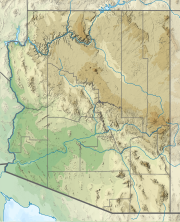Doyle Peak
This article has multiple issues. Please help improve it or discuss these issues on the talk page. (Learn how and when to remove these template messages)
|
| Doyle Peak | |
|---|---|
 Doyle Peak (left, flat top) and Fremont Peak from the east side of Agassiz Peak. | |
| Highest point | |
| Elevation | 11,464 ft (3,494 m) NAVD 88[1] |
| Prominence | 660 ft (201 m)[1] |
| Parent peak | Fremont Peak |
| Coordinates | 35°19′48″N 111°38′47″W / 35.3300087°N 111.6462717°W / 35.3300087; -111.6462717[2] |
| Geography | |
| Location | Coconino County, Arizona, U.S. |
| Parent range | San Francisco Peaks |
| Topo map | USGS Humphreys Peak |
| Climbing | |
| Easiest route | Off trail hike |

Doyle Peak is a peak in the Coconino National Forest, and the fourth-highest peak in the San Francisco Peaks of northern Arizona. It is the sixth-highest named point in the state of Arizona, with an elevation of 11,464 feet (3,494 m).
History of the Doyle Peak and adjacent Schultz Peak
This section is missing information about Doyle Peak. (August 2022) |
A small structure was built to house a telescope on nearby Schultz Peak by Lowell Observatory in 1927. It was referred to by some as a shepherd's cabin. The site was selected by V. M. Slipher, Director of Lowell Observatory, for a pair of bristlecone pine trees oriented in a north-south line. These were cut as supports for the polar axle of the telescope. The telescopes, a 12-inch (30 cm) reflector and a 15-inch (38 cm) reflector, were constructed by Stanley Sykes of Lowell Observatory. The cabin housing the telescope was constructed by a local stonemason. The structure had a corrugated metal roof that could be rolled off to expose the telescope for observations. The observing site also had a small dormitory partially cut into the hillside east of the telescope, but only an indistinct depression remains. From 1927 until 1932, this was the highest astronomical observing site on Earth. This distinction passed to the Swiss in 1932, when they commissioned a slightly higher observing site on the Jungfrau.
The original purpose of the site was to make spectroscopic observations of planets, stars, and nebulae. The high altitude was necessary to exploit increased atmospheric transmission, especially in ultraviolet and infrared wavelengths. A similar telescope and roll-off structure were constructed at the Mars Hill campus of Lowell Observatory so that spectroscopic observations made at the two sites could be compared. The telescope at Mars Hill is still in service, and now mounts a 21-inch (53 cm) reflector. The telescopes and polar axle from the Schultz Peak site still exist, and one of the bearing assemblies from the original roll-off roof has been retrieved from Schultz Peak as a possible future museum exhibit.
Between 1931 and 1933, the Harvard-Cornell Meteor Expedition under the direction of Ernst Öpik, Harlow Shapley of Harvard, and Samuel L. Boothroyd of Cornell used Lowell's Schultz Peak Station as one of its meteor observing sites. They used the vibrating mirror technique developed by Öpik and Boothroyd to measure the velocity of meteors, and they recorded meteor tracks from two locations to compute the altitude of meteors by their parallax. The second observing site for a parallax measurement was originally near Bellmont, Arizona, but was later moved to Padre Canyon, Arizona. In 1933, Boothroyd returned to test the new vacuum deposition technique of mirror coating that had recently been developed at Cornell University. This briefly made the telescope at the Schultz Peak Station the world's largest telescope coated by the new aluminization technique, which remains the preferred method of coating telescope mirrors. Several of the astronomers who used the Schultz Peak Station made important contributions to astronomy, and several scientific papers were published using data obtained at the Schultz Peak Station.
The telescope and polar axle were removed from the Schultz Peak Station in 1937 by V. M. Slipher and some of the junior staff of the Lowell Observatory. The facility was abandoned, and by the 1970s, the roof had collapsed from years of neglect and winter snow.
As of August 2016, the cabin on Doyle has been rebuilt to a functional state. All material was repurposed from what was on the mountain, other than nails and plumbers tape. The ridge beam and rafters were cut in place using dead trees from the top of the mountain. Unfortunately, Doyle Peak and Cabin were heavily affected by the Pipeline Fire in June 2022, and the Cabin has since been burned.
See also
References
- ^ a b "Doyle Peak, Arizona". Peakbagger.com. Retrieved 2009-01-06.
- ^ "Doyle Peak". Geographic Names Information System. United States Geological Survey, United States Department of the Interior. Retrieved 2009-01-06.
